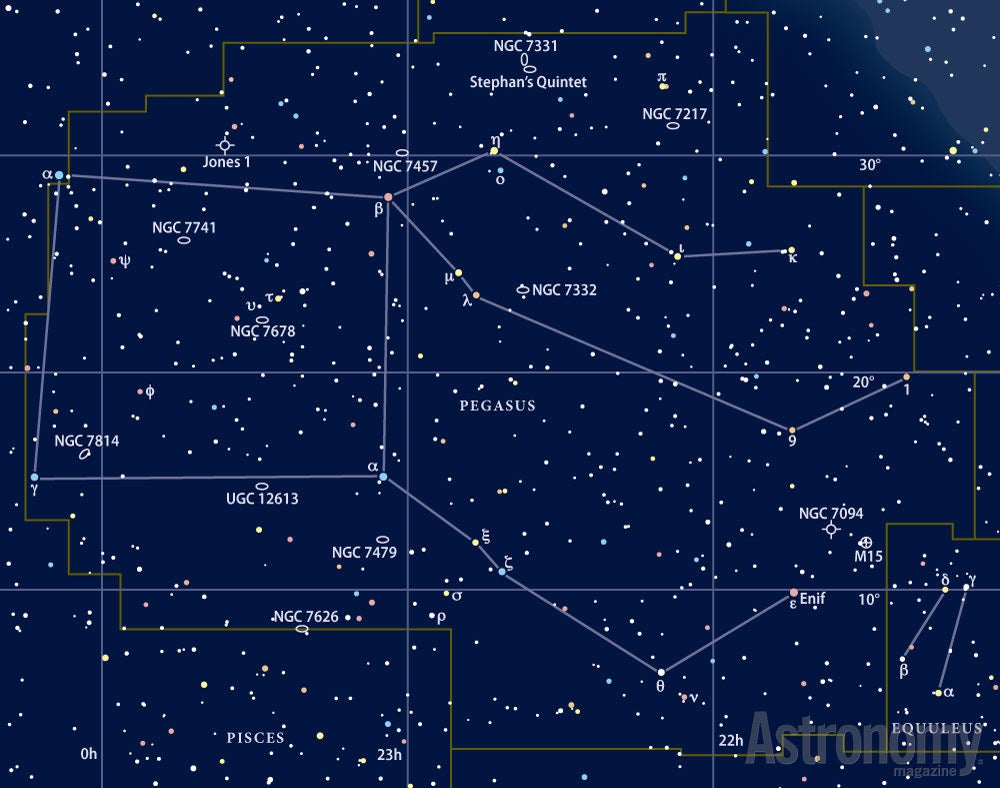Targets for October 8–15, 2015
Small telescope: Open cluster NGC 7788
Large telescope: Spiral galaxy NGC 7678
Large telescope: Barred spiral galaxy NGC 7741
Triple threat
This week’s small-telescope target is open cluster NGC 7788 in the constellation Cassiopeia the Queen. This magnitude 9.4 object is the most northwestern of a line of three open clusters. To find this group, start at magnitude 2.3 Caph (Beta [β] Cassiopeiae), and move 2.5° northwest. NGC 7788 measures 4.0′ across.
The brightest of the triplet, magnitude 8.5 NGC 7790, lies 17′ to the southeast. It appears a bit larger than NGC 7788, spanning 5.0′.
Continue the line another 20′ to the southeast, and you’ll encounter magnitude 9.7 Berkeley 58. It also measures 5.0′ across.
Galaxy in a box
This week’s first large-scope object is spiral galaxy NGC 7678 in Pegasus the Winged Horse.
Here’s a nice deep-sky treat that disproves the notion that nothing lies within Pegasus’ Great Square. Look for NGC 7678 approximately 1.2° southeast of magnitude 4.4 Upsilon (υ) Pegasi.
This magnitude 11.8 face-on spiral has tightly wrapped arms that only begin to reveal themselves through 14-inch telescopes at high power. Its overall size is 2.3′ by 1.7′. Note the nice isosceles triangle of 12th-magnitude stars that frames the galaxy.
A silvery stellar bar
This week’s second large-telescope target is barred spiral galaxy NGC 7741, also in Pegasus. You’ll find NGC 7741 6.2° west-southwest from magnitude 2.1 Alpheratz (Alpha [α] Andromedae).
This magnitude 11.3 object requires an 8-inch telescope to reveal its details. Through such an instrument at 100x, NGC 7741 appears as a mottled, round haze 4.0′ by 2.7′.
Move up to a magnification of 250x, and you’ll see the uniformly lit bar that extends from east to west across the galaxy’s glow. Apertures of 18 inches or more show hints of the faint surrounding spiral arms.
A nice double star consisting of magnitude 9.8 GSC 2254:1685 and magnitude 11.9 GSC 2254:1349 lies at the northern edge of the halo and points to the galaxy’s core. Approximately 20″ separates the two stars.
Expand your observing at Astronomy.com
StarDome
Check out Astronomy.com’s interactive StarDome to see an accurate map of your sky. This tool will help you locate this week’s targets.
The Sky this Week
Get a daily digest of celestial events coming soon to a sky near you.
Observing Basics
Find more guidance from Senior Editor Michael E. Bakich with his Observing Basics video series.











